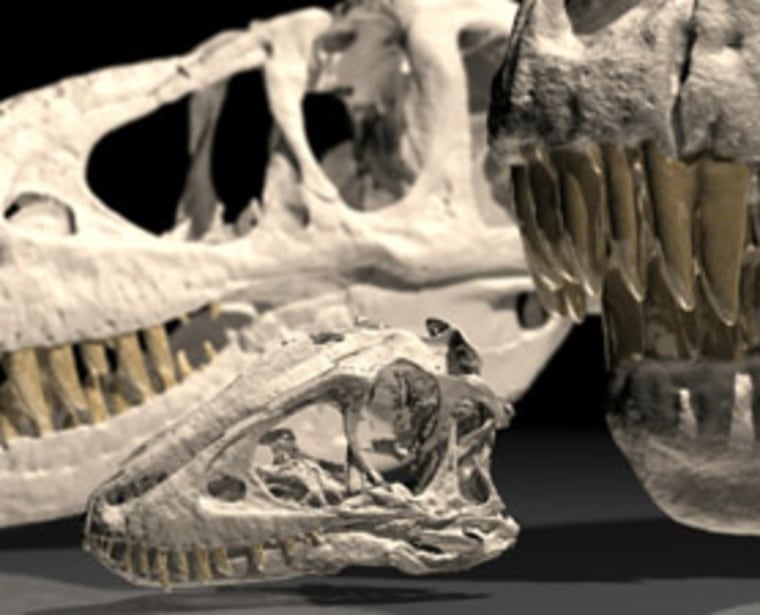The youngest and most complete known skull and skeleton for a tyrannosaur reveal that even juveniles among these infamous carnivores were strong hunters, capable of outrunning and killing other dinosaurs, according to new research.
The remains, described in the latest Journal of Vertebrate Paleontology, belong to a 2- to 3-year-old Tarbosaurus bataar, the closest known relative of Tyrannosaurus rex. It lived 70 million years ago and died young of unknown causes.
While this juvenile dinosaur gives new meaning to the "terrible twos," it also provides evidence that young tyrannosaurs looked and behaved differently than their parents did.
"The adult's head would be much more robust and rugged-looking, with more prominent facial ornaments (such as various crests and bumps), whereas the juvenile's head would have been much sleeker and more delicate looking," co-author Lawrence Witmer told Discovery News. "Many of us humans get kind of nastier looking as we get older too!"
"There would have been other differences, such as longer, more gangly, legs in the juvenile and generally a more slender body," added Witmer, an Ohio University paleontologist.
He and his colleagues made the determinations after extensively analyzing the young dinosaur's remains, which were unearthed in the Gobi Desert of Mongolia. The researchers believe the Tarbosaurus was 9 feet in total length, about 3 feet high at the hip, and weighed about 70 pounds.
In contrast, adults of this species were 35 to 40 feet long, 15 feet high, and six tons in weight. The life expectancy was probably about 25 years, based on comparisons with T. rex.
"Tarbosaurus is found in the same rocks as giant herbivorous dinosaurs like the long-necked Opisthocoelicaudia and the duckbill hadrosaur Saurolophus," said Mahito Watabe, who led the expedition to Mongolia and is at the Hayashibara Museum of Natural Sciences in Okayama. "But the young juvenile Tarbosaurus would have hunted smaller prey, perhaps something like the bony-headed dinosaur Prenocephale."
The head of the youngster was too lightweight to handle the biting, twisting and chomping required of its parents' larger prey, but the juvenile dinosaur's long legs suggest that it was a fast and agile runner. Prenocephale was probably just one of many animals that young Tarbosaurus likely hunted.
"There are also several lizards known from the Nemegt Formation, and they were other potential targets for the juvenile," co-author Takanobu Tsuihiji of Tokyo's National Museum of Nature and Science told Discovery News.
The differences between juvenile and adult tyrannosaurs may have reduced competition among them and strengthened their role as dominant predators in their environments. Since young Tarbosaurus was no weak toddler, the discovery helps to bolster the argument that tyrannosaurs were active predators and not just scavengers, as some other paleontologists have suggested.
That doesn't mean the meat-hungry dinosaurs would have passed up a free meal.
"The youngsters probably took mostly live prey and maybe some carrion, whereas the older guys would have had the power to kill, but also the imposing size to take over the kills of others and feast on carrion," Witmer explained.
Stephen Brusatte, an American Museum of Natural History paleontologist, told Discovery News that the young dinosaur "is an exceptional discovery" that "provides a remarkable glimpse into the anatomy, body proportions, and diet of young tyrannosaurs."
"This specimen is especially important because it is so well preserved, and because it is so young," Brusatte added. "It tells us what a toddler tyrannosaurid would have looked like, and it's thrilling to visualize what these quintessential dinosaurian super-predators looked like when they were so small and young."
Since the young Tarbosaurus' remains can unequivocally be linked to a particular species, they may, in the future, shed important light on more controversial isolated fossil finds.
